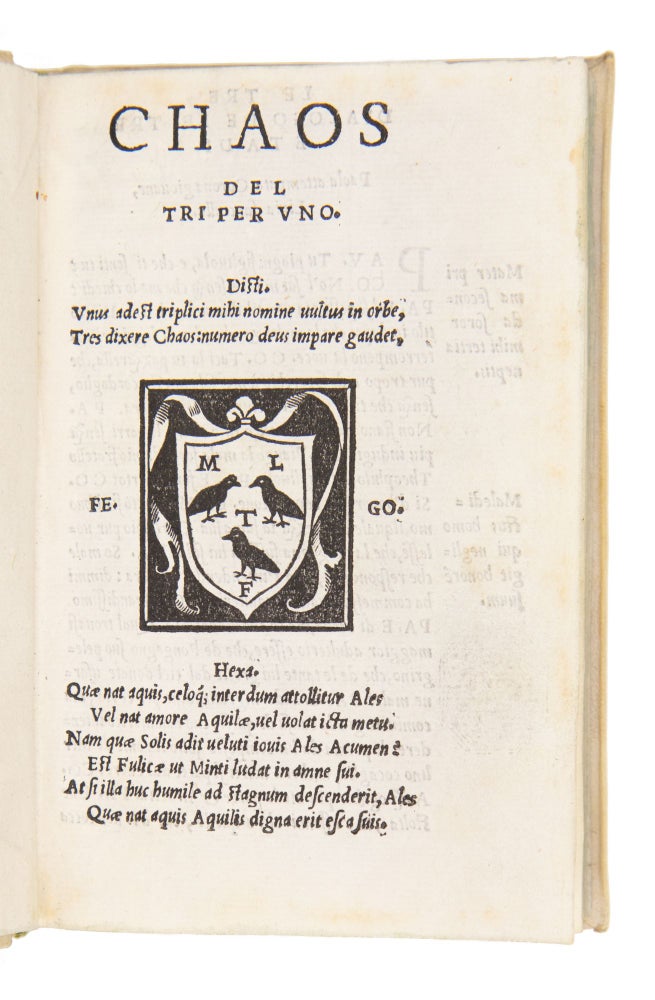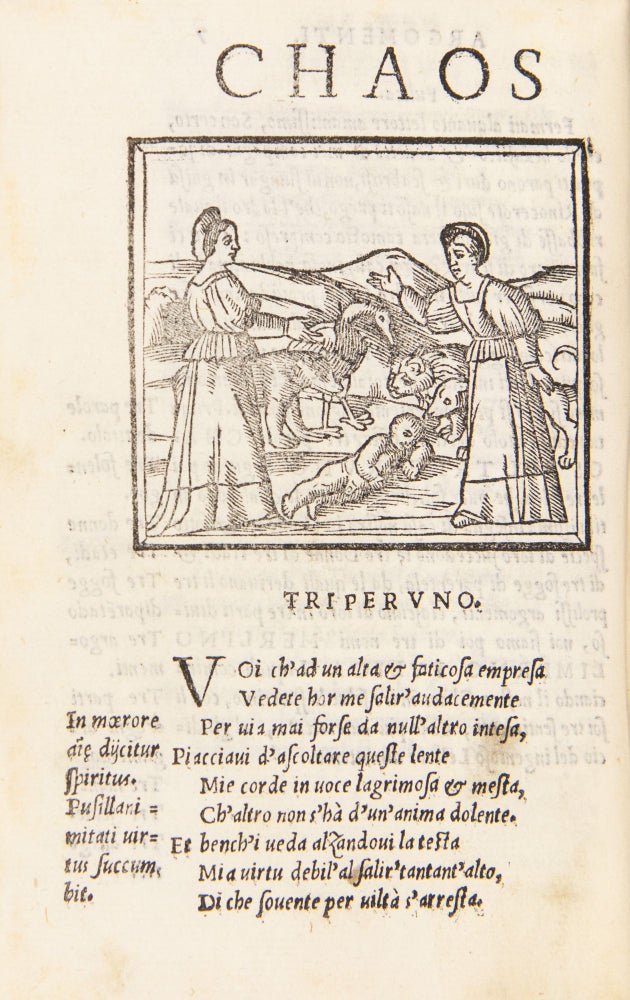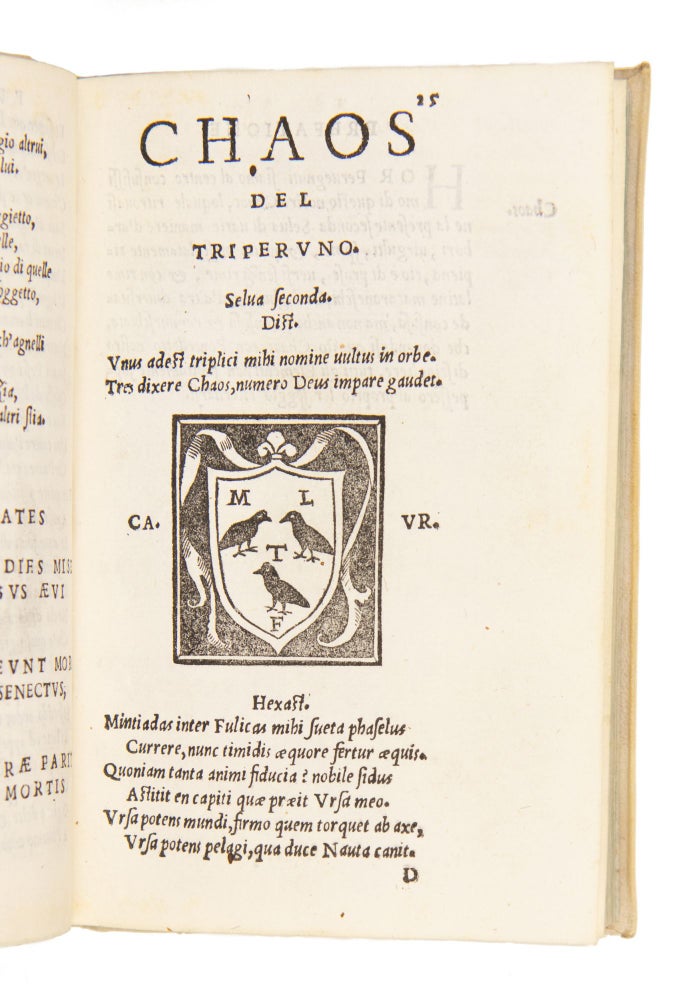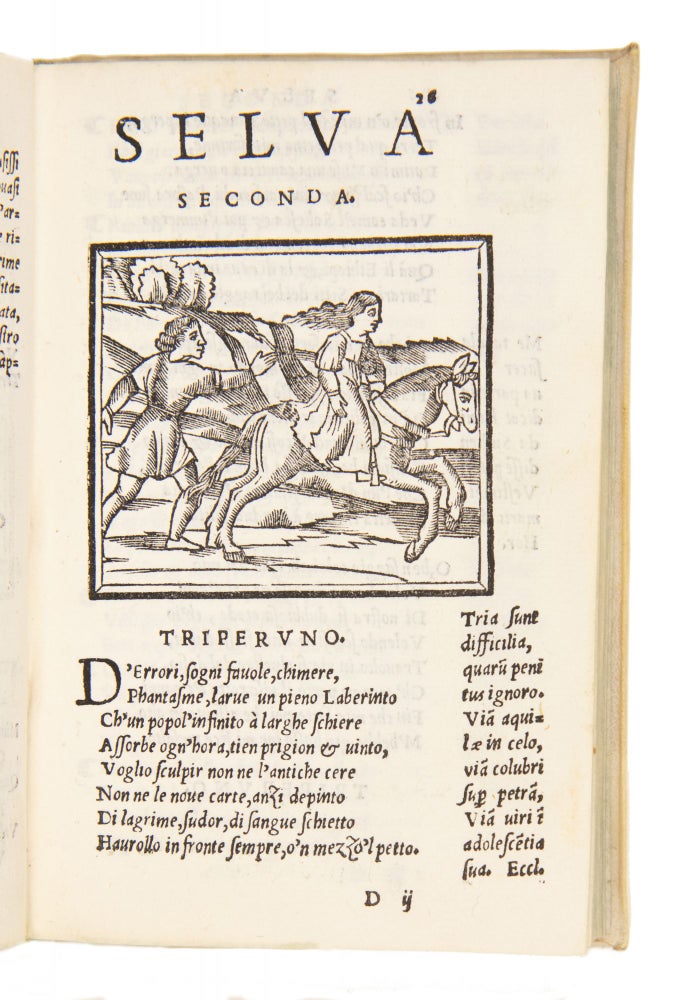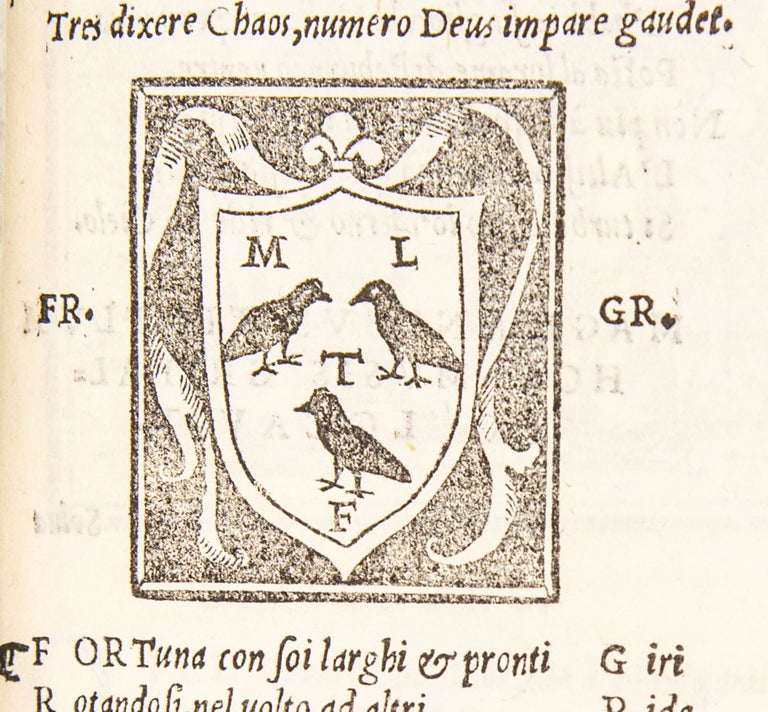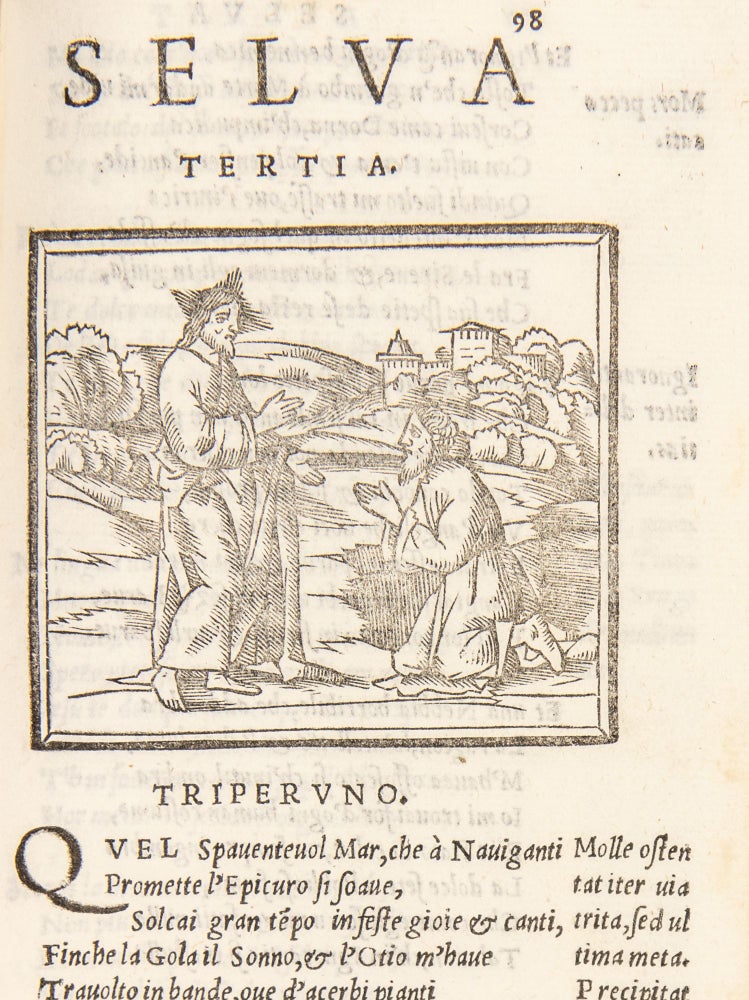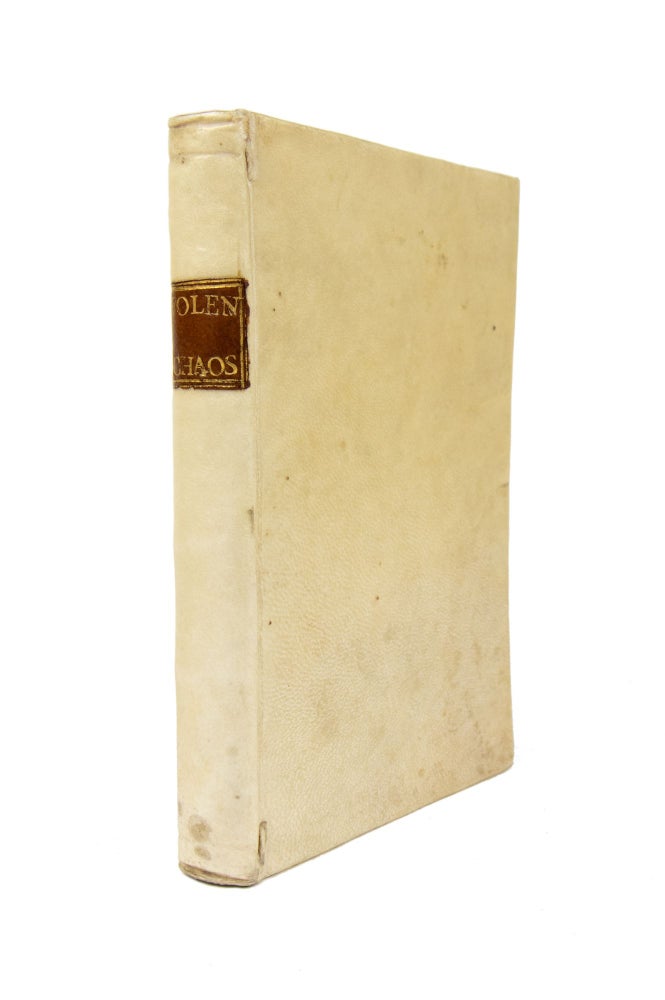Chaos del tri per uno.
Venice: Giovann’ Antonio e Pietro fratelli de Nicolini da Sabio, 1546.
Price: $4,900.00
Octavo: 14.7 x 9.2 cm. 112 lvs. Collation: A-O8.
SECOND EDITION (1st 1527, also by the Sabio brothers.) For this second edition, some explanatory notes have been added to the political sonnet “Europa mia, quando fia mai che l’una”, from which offending verses had been omitted in the first edition.
Bound in 18th-century stiff parchment with a gilt lettering piece on the spine. A fine, clean copy with just some occ. light foxing, a marginal stain on a few leaves, and a small worm hole to the last two leaves slightly affecting the headline. Last leaf backed (and with light foxing).
On the title page (and repeated on ll. D1r and M1r) is the woodcut emblem of the author with the initials M.L.T.F. (“Merlino Limerno Teofilo Folengo”), the initials FE for Federico II Gonzaga, duke of Mantua, and GO, which stand for Francesco Grifalcone, a friend of the author, and for Camillo Orsini, captain of the Republic of Venice and Folengo’s patron. The book is dedicated to all three men). Illustrated with 3 half-page woodcuts in the text. I have located a single copy (UCLA) in North America.
“il ‘Chaos’ continua tuttora a creare più enigmi di quanti ne risolva, complicato dagli specchi collocati del suo autore in pagine cruciali, a riflettere la materia poetica secondo prospettive spesso impenetrabili.”(Giordano Rodda)
[“The ‘Chaos’ still continues to create more enigmas than it solves, a problem complicated by the mirrors placed by its author in crucial passages to reflect the poetic material according to perspectives that are often impenetrable.”]
Folengo’s bewildering, allegorical, autobiographical “The Chaos of Three-for-One” charts the spiritual, moral, and artistic evolution of its protagonist, Triperuno. The book opens with a prologue in prose, in which Paola, Corona and Livia - the three women of the Folengo household, respectively mother, sister and niece - meditate on the author’s activity and the events of his life, in particular his important decision to leave the Benedictine monastery in 1525. The text proper is divided into three parts, called selve (‘forests’), in which Triperuno interacts with three interlocutors, all of them versions of the author: Fulica (Latin for “Folenga”), Merlino, and Limerno (the former a well-known pseudonym of the author, the latter a heteronym of the first).
“Chaos” is composed in a bewildering, labyrinthine mixture of languages (Mantuan Italian, Latin, macaronic) and genres. Structurally, the work is a “prosimetrum” on the model of Dante’s “Vita Nuova”, Boccaccio’s “Ameto”, and Sannazaro’s “Arcadia”; the “Chaos”, however, has an even more elaborate and complex structure, programmatically founded on the number three, and contains all kinds of metrical and prose forms (narrative, dialogue, oration, satire, biography, etc.) so as to represent almost all the prose and verse genres known at the time (cf. A. Daniele, “La forma del Chaos”, in: “Teofilo Folengo nel quinto centenario della nascita”, Florence, 1993, p. 331).
The work “contains instances of split personalities, eccentric scandalous behavior, and an intense search for truth; it exhibits sharp contrasts in style including inserted genres. Triperuno exhibits the moral, psychological and philosophical experimentation common to Menippean satire, and like it, it makes steps towards a social utopia.”(Mullaney, Teofilo Folengo: Ecce Homo p. 127)
A synopsis of just one passage conveys something of the experience, if not the full linguistic flavor, of the work:
“Presented with two alternatives, Virtue and Fortune (Chance), the young Triperuno chooses the right fork (Virtue), moved by the wise spirit of the Benedictine fathers. But he is prohibited from entering the path of Virtue by some sinister women, who drag him under the shade of a myrtle tree.
Quivi tra loro un lupo immantenente
comparse (onde non so) minace ed irto
del quale una di lor, se ben rimembro
svelse sdegnando il genitale membro
“After castrating the wolf, these women suck its blood, and become mules… The drained wolf is then suddenly transformed into a steed, upon which rides the myrtle tree turned into ‘Fortuna.’ Together they chase Triperuno. Then, again in their human form and “sott’ombra della petrarchesca Laura,’ the women sacrifice a tender unicorn. A lightning storm erupts, and Merlin appears in the nick of time.”(Ibid, p. 154)
Verses on the Tarot:
“[Folengo’s] importance to tarot history lies in the oddly-titled ‘The Chaos of Three for One’, [which] contains a set of five sonnets that make use of the names and imagery of all twenty-two trumps. The verses are interspersed throughout the dialogue of two men, Triperuno and Limerno (the latter being another of Folengo’s literary pseudonyms.) Limerno has been commanded to recite poetry for the queen and has written sonnets for four people, two women and two men, all of whom have been dealt trump cards. The cards form the basis for each sonnet and for a description of the character of the person to whom they have been dealt.
“The meanings assigned to the cards are fairly obvious, face-value ones: Justice means justice, the Lovers (or Love, as the card was then called) means love, and so on. The Tower is referred to as Foco (fire), and Judgment is called the Angel, both recognized name variants of the time. However, the important fact for us is that the cards are referred to as ‘sortes’(‘destinies’, or ‘lots’), and are used to form character sketches.
“Folengo’s use of the cards to devise sonnets began something of a craze among sixteenth-century Italian aristocrats for a game that came to be known as ‘Tarocchi appropriati’. Here trump cards were selected by one player and presented to another, who would interpret them thematically by a process of idea association to create verses about himself or herself, about another person, or -most popularly- to praise well-known ladies at court.”(Paul Huson, Of Cartomancy and the Tarot, p. 50-1).
Edit 16, CNCE19369; Adams, F-686; L. Carpané, Nicolini da Sabbio, p. 217


